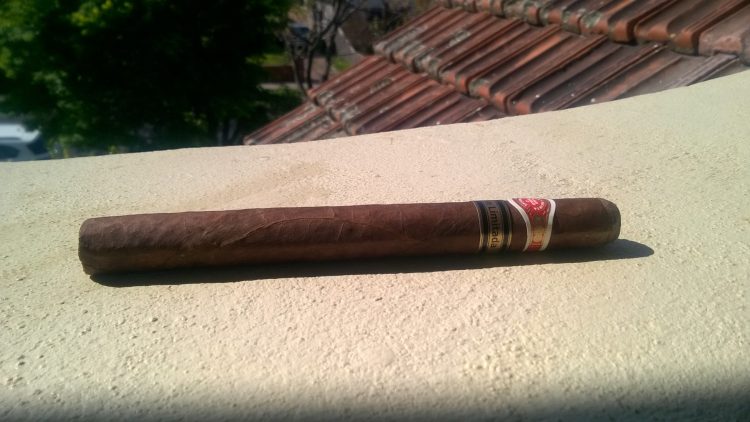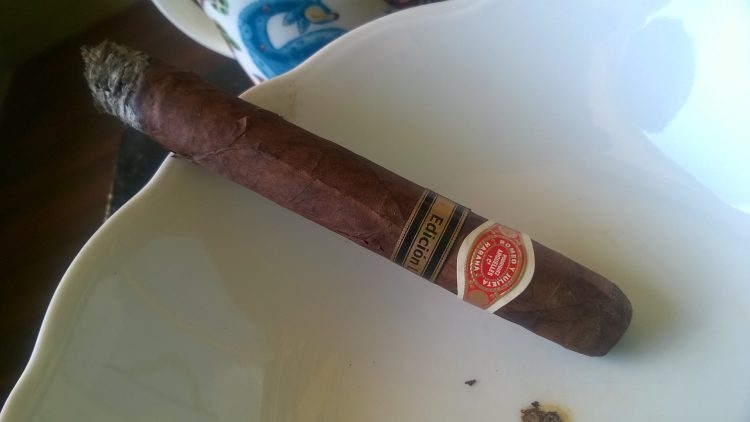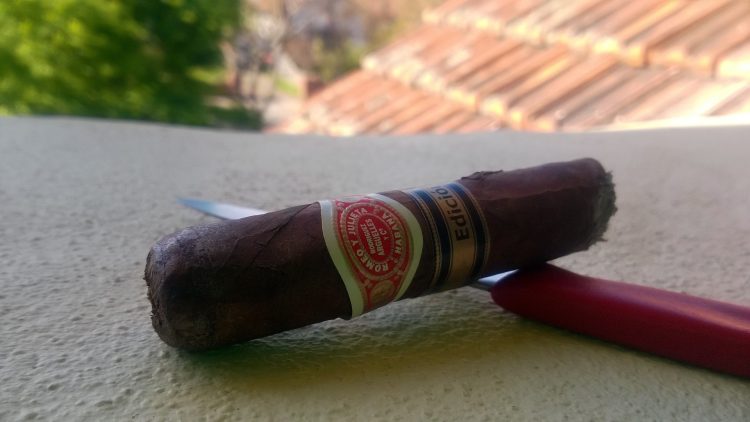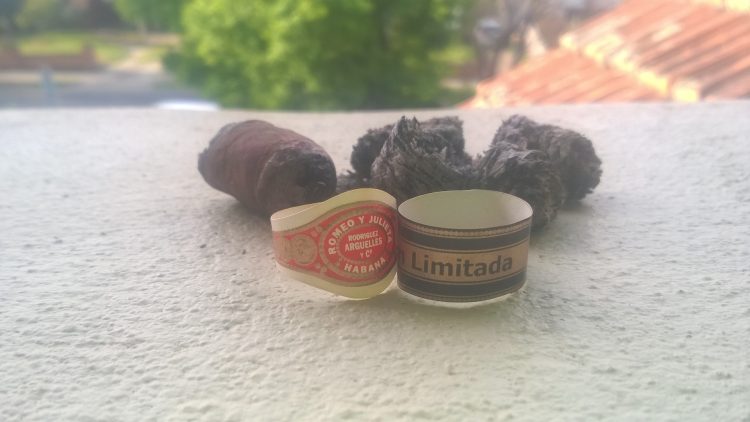Dusky Beauties has always been about the verticals, the tasting of every special cigar across an entire marque, but in this our fourth season, the horizontals are starting to come together too. We already have two of the 2000 Edición Limitadas, the Monte Robusto and the Partagás Pirámides, and today we add a third, the Romeo y Julieta Exhibición No.2. The horizontals are really more meaningful than the verticals; some harvests are better than others, styles change, and the men working in the blending room sometimes get colds and can’t smell properly. You can guess more about how a cigar will be by looking at other cigars made in the same year than by cigars from the same brand made six years later. Unfortunately, this does not bode well for the Exhibición No.2: its siblings were both nice, but ruined by their fireproof Habanos 2000 wrappers. It’s a lovely looking thing, a silky and rich cocoa black but, at 7.6 inches long, if this cigar doesn’t burn it is going to be a brutal afternoon.
It lights without too much trouble, and begins as well as any cigar, with sweet floral notes over a pungent mid-tobacco. I don’t know much about flowers. In general, when I say “floral notes,” I mean the smell of a florist: a generic, rose heavy mélange. With the floral notes in the Exhibición No. 2, however, I can be more specific: it’s hibiscus. To be more specific still, it’s the hibiscus that grew on the pergola at my childhood home in Papua New Guinea.
I lived in PNG during my earliest years, ages two – five. My memories from that time are just snippets, coloured perhaps, but the oral traditions of my family, and the few grainy home movies that my dad made, where I can be seen babbling about my Lego, and in one chewing vigorously on a hosepipe while my sister recounts an anecdote. I remember that we had a lot of animals: Ernest, a placid tortoiseshell cat who we adored (mainly because he would let us kids pick him up and drag him around without ever showing any ill will), and Mathilda, a less cooperative tabby (she disappeared one night, and my parents told me that someone from the squatter’s village down the hill had turned her into soup). There was also Crumpet the dog and her short lived litter (mentioned previously), and two turtles, whose names I forget, but they were great, fat things, with rolls of blubber where their flippers emerged from the shell. We would feed them dry cat food, tossing a handful into the turtle tank, where the pellets would engorge in the water, and the turtles would nipple at them from underneath. The cats would sit on the edge, trying to fish the pellets out with their paws.
The menagerie continued in the backyard with two sheep, Oscar and Rosie, one each for me and my sister. Oscar (named for the grouch) was mine, and at some point he got sickly, and was taken away. My mum told me years later that when they cut him open he was a mess of tumours inside. Finally, in a cage under the house there was Gus, a vicious tree-kangaroo who I don’t remember much about, except that I was told he was very dangerous, and was under strict orders never to approach his cage.
At the midpoint the cigar is very light, slightly dry, with some earth and straw notes, not unlike the inside of an Asaro Mudman’s mask. You want a cigar like this to be light in the middle – too much kick now and the end would be too bitter. Its fifteen years are showing, too, bringing out the subtleties. Very pleasant.
From my point of view, life in PNG was an idyllic frolic, playing in the mud with my friends, throwing rocks and climbing trees (my parents worked, leaving me in the care of a local nanny, who didn’t see the need to supervise the white boy any more than the other children in the village). Sure, every now and again someone would have a two-foot parasitic worm crawl out of them, but that was just part of life, wasn’t it? There was always a bit of an undercurrent of danger, though, that I don’t think I was fully aware of.
In the hills outside of town, for example, there was occasionally a checkpoint where men in traditional warrior garb and brandishing spears would stop our car to demand a donation for the local boy scout troupe. I remember another incident too, where mum hit a pig on the road, and the entire tribe showed up at our house to negotiate a settlement. The closest brush I ever had though came when we weren’t even at home.
My family and I were back in Australia on holiday, and we had left the house and our menagerie in the care of Helen, a single woman friend of my mother’s. The house stood on stilts, in the Queenslander style. In the cavity underneath there was (aside from Gus’ cage) all manner of junk, including a pair of huge packing crates (that at one point had contained industrial sized generators for the school my parents worked at). The generator crates sat directly under the floor to the bedroom that my sister and I shared, with perhaps a twelve-inch gap between. Under my bed and, therefore, above the crates, was a long forgotten trap door, now screwed down.
About a week into Helen’s residency, a rascal from the squatter’s village wandered up the hill and, snooping about the junk pile for something to pinch (he was undeterred by Gus’ hissing), discovered the trap door. We can only speculate how long he lay on the crates, or what his intentions were, but in the morning they found a little bed he’d made for himself down there. In the evening, once it was dark, he unscrewed the trapdoor and climbed up into our bedroom.
Helen was watching TV in the lounge-room when she heard some odd scraping noises coming from the kid’s room and, thinking it was one of the animals, she went to investigate. She opened the door and snapped on the light, startling the man who was standing in the middle of the room. Helen screamed and ran, and the man chased her, brandishing the screwdriver. In the lounge room she had a flare gun that a neighbour had lent her, half-jokingly, for self-defence. She fired it at the intruder, hitting him in the hand. He dropped his screwdriver and fled. The flared ricocheted and left a burn mark in the hallway. As the man ran back to the trap door she fired again, this time catching my bedroom door, that he was in the act of slamming behind him. The flare left a small round hole with blackened edge, right about my eye level. I used to play that it was a peep-hole.
Helen ran screaming to the neighbour’s place, and the police came, but the man was gone, and there wasn’t a lot the cops were inclined to do. “Forget it, Helen, it’s PNG.”
The epilogue to the story is the death of dear Ernest. After the incident, Helen understandably wanted a little more protection around the house, and borrowed a giant brute of a Rottweiler from a neighbour, which she chained up on the front porch. Ernest, normally a free range cat, was confined to the indoors while the dog was in residence. One evening she opened the door and Ernest, evidentially eager for some fresh air, came darting out. The dog got a hold of him, and a beloved childhood pet met his end.
The cigar has remained mostly very mild, but in the last two inches it starts to bitter up a bit, with a sweet and nutty spice. Some cinnamon. This is a fantastic example of a mature cigar. It is not dried out and tasteless (like the aged Romeo Churchill I smoked some years ago), but instead has a sweet, nuanced mildness. It will barely leave an aftertaste.
Very interesting here is that the burn has been utterly unimpeachable: it lit in moments, has had no relights, no touch ups, and been straight all the way, a miracle compared to the Monty and the Partagás of the same year. Evidentially some decent wrapper existed back then.
Better than the Petit Coronas.
Romeo y Julieta Exhibición No.2, Edición Limitada 2000 on the Cuban Cigar Website



